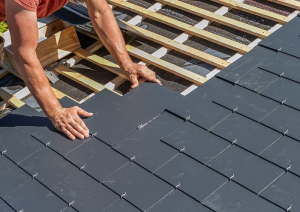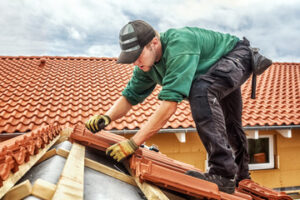Choosing the right metal roofing is a big investment and is best left to a professional contractor. Whether you are replacing your existing roof or building a new structure, a metal roof can add beauty, style, and value to your home or commercial project. The benefits of a metal roof include longevity, durability, energy efficiency, and fire resistance. Contact Metal Roofing Columbus GA now!
Unlike tiles and shingles, which must be replaced frequently or can come loose during storms, metal roofs can withstand high winds and heavy snow loads. They are also long-lasting and can last 50 years or more with minimal maintenance requirements.

When choosing a metal roof, it is important to choose a product that has been certified by an independent testing lab (such as the Underwriters Laboratory) and comes with a lengthy manufacturer’s warranty. Also, consider choosing a contractor that offers a labor and materials warranty on the installation.
Start with removing all the old shingle and wood decking, making sure to dispose of it properly in a debris container. Then install the underlayment. It’s important to use an underlayment that is water-resistant, such as synthetic underlayment. It is not recommended to use asphalt felt underlayment, as it doesn’t hold up to the elements well.
Once the underlayment is in place, begin installing your metal panels. It’s important to overlap each panel by at least 3 in (7.6 cm). Once all the panels are in place, join them with metal seam clips to ensure that they are securely fastened.
A roof is an important part of a home, and the material it’s made from affects many aspects of its function and design. When choosing a roofing material, consider its lifespan, durability, water resistance, insulation needs and visual appeal.
There are many different types of roof materials, each with its own benefits and drawbacks. Some are more cost-effective, while others offer better fire resistance or energy efficiency. Some may be more suitable for certain climates or architectural styles. It’s also important to consider the installation and maintenance requirements of each type of roof.
The most common roofing materials include asphalt shingles, clay tiles, concrete tiles and metal. Asphalt shingles are the most affordable and durable, and come in a wide variety of colors and styles. They are easy to install and are resistant to rot and insect damage. These shingles are also relatively lightweight, which can reduce the amount of stress on the structure of the house.
Concrete tile is another durable option that can mimic the look of many other types of roofing materials. It’s also fireproof (class A), waterproof, and impervious to fungus and other microorganisms. However, it can be expensive and difficult to work with. It’s also a good idea to use flashing, which is a protective layer that prevents leaks at the joints of the roof.
Tile roofs are an attractive and durable roofing option that can last for over 50 years. They are available in a wide range of shapes and styles, from Mission-style round topped tiles to French-style flat roofs. This type of roof is best suited for warmer climates, as it tends to absorb moisture and become brittle in cold weather.
Metal roofing is a stylish and durable roofing option that can last up to 70 years. It can be made from corrugated or standing seam metal, and is available in a range of finishes to match the style of the house. It is also energy efficient, as it can reflect heat rather than absorb it. It is also highly recyclable, which makes it a sustainable choice.
Design
The roof may be a home’s most visible feature, but its design goes well beyond its aesthetic. From the gently sloping shingles of cozy cottages to the dramatically pitched copper roofs of European cathedrals, every roof is uniquely designed to suit its climate and architectural style. In addition, the design of a roof can also affect how it functions.
For example, the slope (also known as the pitch) of a roof is important to its ability to shed water. A roof with a steeper pitch is more likely to shed water faster than a roof with a shallower pitch.
Other design considerations include the location of plumbing vents and other penetrations. All new and re-roofing projects should thoroughly pursue moving penetrations to the least exposed side of the roof.
Installation
A home’s roof is its main barrier to the weather. It protects a structure’s inhabitants from extreme heat and cold and keeps water from seeping in. Nevertheless, many people do not fully understand the role of roofing or what goes into its installation and maintenance.
When installing shingles, a contractor will first put down underlayment, which is a waterproof membrane that prevents leaks and shingle damage even if the outer layer suffers minor damage. Then, he will nail the shingles in a pattern that overlaps by six inches. The cap nails will be closer together at the edges and spread out more towards the center.
Before a roofing project begins, the homeowner should mow the yard and move all objects from the house (such as cars or patio furniture). He should also cover landscaping with tarps, position garbage cans to prevent rainwater from falling into them, and remove or flag any items that could fall off the roof during construction.
Maintenance
The roof acts as the main barrier between your home or commercial space and the weather. It should be inspected regularly to ensure its integrity and longevity. Detecting and repairing small problems before they escalate into major issues can save you thousands of dollars down the road.
Look for a variety of signs of wear and tear. Depending on the season, these may include:
Loose, cracked, or curled shingles Missing granules (which expose the asphalt layer and accelerate shingle deterioration) Broken or damaged flashing
Water leaks around chimneys, vent pipes, skylights, or other penetrations can damage the roof covering and lead to structural damage. Checking the caulking on a regular basis and re-caulking as necessary will help prevent water leaks.
Inspect for rust and other metal degradation on the underside of the roof, especially near the edges. A roof is more vulnerable to wind and sun exposure than the rest of the structure, so these areas require special attention.
Keep drains clear of debris such as dirt, leaves, and twigs. If left to accumulate, this can prevent water from flowing into roof drains and cause ponding, which can lead to premature damage or leaks.
Trimming the growth of trees near your home or commercial space can protect it from branches that might fall during a storm. This can also reduce the risk of damage from flying debris caused by strong winds and natural disasters like tornadoes and hurricanes. A regular roof inspection should be done by a trained professional on a routine basis. This should be recorded in writing so that problems are addressed before they become serious.
Leaks
If a roof is not routinely maintained, it can quickly deteriorate and require major repairs. This can increase the life-cycle cost of a roofing system, and may also put interior valuables at risk. In addition, untreated deterioration can result in a warranty being voided. Performing maintenance on the roof, including a regularly scheduled inspection, can help to extend the life of the roofing system and reduce the overall life cycle costs. This is especially important for facilities that utilize a large amount of energy, as a less efficient roof can lead to high energy bills.
Repairs
When it comes to addressing roofing damage, repairs can often make the difference between saving your roof and replacing it. But it’s important to understand the differences between repairing and replacing a roof, so you can make an informed decision about your home improvement project.
Roofing professionals can replace worn out shingles, tar paper, and flashing, as well as seal up gaps to prevent water intrusion. But when the extent of damage to your roof is too severe, a full replacement may be necessary.
Generally, a complete tear-off and replacement requires a permit. This is especially true for older buildings and those located in Landmark Districts or Historic districts, as these types of projects have specialized requirements that must be met. In many cases, it’s best to have a licensed contractor pull the permit, as they’ll be familiar with the process and requirements. A permit also allows you to get the warranty coverage you need, ensuring peace of mind and proper protection for your investment.
